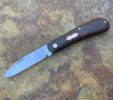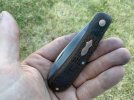I mostly use gold or silver. Occasionally I use nickel silver or bronze. The brazing material is hard silver solder for all of these except gold, on which I use gold solder. I mark the spot on the shield from back through the holes in the scale. If there is any misalignment, I either move a pin, or enlarge/oval a hole.
I used to have a neat little jewelers spot/tack welder that would fusion weld a small object. It was originally used to repaid eyeglasses frames. I got it in a box a free equipment when an optician retired. It was very handy for tasks like welding gold and silver pins and posts on jewelry. I loaned it to a friend who was dying, and wanted to fiddle in his shop. After he died I found he had loaned it to another jeweler. I contacted the other jeweler and she said he had given it to her. I explained it wasn't his to give, but she got really defensive about it being hers. I told her to keep it and hoped she could sleep well knowing she had something that wasn't hers. She called a week later and said she would return it. When I got it I found out she had burned out the transformer, probably trying to weld something too thick or maybe stainless steel. I just sent he a smiley face message saying, "Thanks, works great". The new ones are over a grand now, so I never replaced it. I may try and re-build it someday ... if I can find where I put it.




